From inside (document excerpt):
Reel Mower TERMINOLOGY DEFINITION OF TERMS Aerate — Process of coring, spiking, slicing, or other methods to introduce air from the atmosphere into the soil and thatch without destruction of the turf; synonymous with aerify. Aftercut Appearance — The general appearance of the cut path after mowing. Quality of cut as well as marks left by rollers, wheels, and dispersion of clippings affect appearance.
When all is said and done, a good after cut appearance is what the superintendent and players want. Annual Bluegrass — Annual bluegrass (POA ANNUA) is widely dispersed as a winter annual in both coolseason and warm-season turfs. It is also used as a perennial turfgrass on intensively cultivated sites in the cool temperate and subarctic climates. Within a few years after establishment, closely mowed and intensively irrigated bentgrass fairways will have some encroachment of annual bluegrass. Annual bluegrass may also become a dominant component of a fairway polystand within five years. Many older golf courses are basically composed of annual bluegrass, primarily the perennial types. Fairway Terminology InfoGuide Backlapping or Lapping– A method to simultaneously sharpen the cutting edges of the reel blades and bedknife. Backlapping is done by reversing the rotation of the reel from the normal mowing direction. A abrasive paste (slurry) is applied the to the rotating reel blades with a long handled brush to aid in the sharpening process. There are different grit pastes and grades depending on need. Bedbar — The supporting structure to which the bedknife is attached. Bedknife Attitude The angle between the bottom of the bedknife and the ground plane under the cutting unit. As the bedknife attitude is changed, it is important that the reel to bedknife shear point changes relative to the center line of the reel. This can change the after cut appearance of the grass. The result may be better or worse depending on several factors. Shear Point Attitude Bedknife attitude is adjusted by changing the height of the front, rear, or both rollers. A height of cut change is NOT necessarily part of a change to the bedknife attitude. A large angle is also referred to as an aggressive bedknife attitude. A small angle (flat attitude) can have most or all of the bedknife riding ON the turf. This can influence after cut appearance. Bedknife — The lower cutting member on a reel type mower. The bedknife is attached to the bedbar, and the assembly is mounted to the main frame in one of two ways. One allows for paralleling and adjusting the bedbar (bedknife) up to the reel, while in others the bedbar is fixed and the paralleling and adjustment are made by moving the reel. bedknife -2- Fairway Terminology InfoGuide Bentgrass (cool-season turfgrass) — Creeping bentgrass is the main turfgrass used on intensively maintained fairways in cool climates. Creeping bentgrass succeeds at cutting heights of less than 0.8 inches, mowing at one- to two-day intervals, heavy irrigation, moderate fertilization and the use of fungicides. Colonial bentgrass is sometimes used with creeping bentgrass as a polystand. Bermudagrass (warm-season turfgrass) — Bermudagrass is adapted to a wide range of soil conditions. Although not very cold tolerant, several new cultivars have been developed which respond better in cooler temperatures. The improved Bermudagrass cultivars have excellent wear, heat, and drought tolerance plus a rapid recuperative rate. Their most common problems are a potential for thatching, shade intolerance, and susceptibility to insect pests. Bobbing — An undesirable cutting unit movement that leaves an unacceptable wave-like appearance. As a general rule mowing slower should lessen the problem. Brushes or Combs — Attachments generally installed on the cutting unit to lift the grass blades resulting in a cleaner cut. They also promote a more vertical growth and prevent or correct grain in the grass. Clip (Clip Distance) — The distance between sheer points. Factors which affect clip include: · The number of reel blades · The ground speed · The rotational speed of blades Under close examination grass that has been properly cut with a reel mower will have a uniform wavy appearance. This is because of the gathering action of grass caused by the combined forward motion of the bedknife and the pulling action of the reel blade. When the three factors above and height of cut are in a proper relationship, then the normal wavy cut will be difficult to see and the -3- Fairway Terminology InfoGuide cut will usually be judged as good. If the factors are out of proper relationship the wavy cut may be very noticeable and will be unacceptable. This unacceptable wavy cut goes by several names that are used interchangeably, including marcelling, wash boarding, wave cut and corrugation. Clip vs. Height of Cut — The general rule of thumb concerning height of cut versus clip is that the best visual appearance occurs when the clip distance is close to the height of cut. Clip distance approximately equal to HOC Clip distance different than HOC Clumping — The discharge of clippings into unsightly lumps or rows. Excessive clippings besides being unsightly may smother the grass or act as incubators for disease. Combs or Brushes — Attachments generally installed on the cutting unit to lift the grass blades resulting in a cleaner cut. They also promote a more vertical growth and prevent or correct grain in the grass. Compaction — Soil particles pressed closely together. Soil compaction prevents adequate water and air penetration and reduces turfgrass root growth. -4- Fairway Terminology InfoGuide Cool-season Turfgrasses — Cool-season grasses grow best within a temperature range of 60° to 75° F. Their environmental adaptation is limited primarily by the intensity and duration of seasonal heat and drought stresses. Cool-season grasses are generally adapted to temperate and subarctic climates. Examples: Annual bluegrass (POA ANNUA), bentgrass, Kentucky bluegrass, fine-leafed fescues. Corrugation — An UNACCEPTABLE wavy or washboard pattern on the surface of mowed turfgrass. Counterbalance — Refers to the transfer of weight between the cutting units and tractor to achieve desired traction and/or contour following. Counterbalance is usually achieved with springs or hydraulic cylinders. Transferring weight between traction unit and cutting units can increase traction and stability, reduce c/u ground drag and steering effort, and minimize scalping. There may be a compromise between good traction and good contour following. Counterbalance Spring -5- Fairway Terminology InfoGuide Crown — The thickened part of the grass plant closest to the soil from which roots extend down and blades shoot up. Cultivar — A plant of a single species that differs from another in specific characters such as disease resistance, leaf width, insect resistance. Cultivation — A mechanical procedure such as spiking, grooving, water injection, or core-removing on established turf to improve its characteristics. Cutting Action — A reel type mower cuts grass with a scissor-like shearing action as the moving helixshaped reel blade passes over a stationary bedknife. This cutting action requires that the bedknife and reel blades be sharp, matched, and in close relationship with each other. Cutting Height or Height of Cut — BENCH SET: The height at which the top edge of the bedknife is set above a flat level surface that contacts the bottom of both the front and rear roller EFFECTIVE HEIGHT OF CUT: The height of cut on the turf. This will usually be higher than the bench setting because the rollers/wheels will not sink into the turf to the ground level. Generally, within the H.O.C. range for a given species or cultivar, mowing too closely weakens the plant, causes shallow rooting, lowers resistance to drought, increases susceptibility to fungus diseases, and encourages thinning of turf. In addition, close mowing brings more light to the ground surface and encourages the germination and growth of weedy grasses and broadleaf plants. -6- Fairway Terminology InfoGuide For example: A bench setting of 1 inch may result in an effective or actual cutting height of 1 1/16 inches because of the plant material that elevates the rollers. NOTE: Two different cutting units set at the same BENCH HEIGHT OF CUT may have a different EFFECTIVE HEIGHT OF CUT because they have different total weights, rollers, skids and bedknife attitudes. Cutting Unit — The cutting unit consists of a reel, front and rear rollers, a bedbar/bedknife assembly, and related adjusting mechanisms. Bedbar/Bedknife Adjusting Mechanism Front Roller Reel Dethatching, Thatching or Verticutting– The thinning of turf grasses by blades or wire tines which cut perpendicular to the soil surface. -7- Fairway Terminology InfoGuide Dispersion of clippings — The pattern of how clippings are thrown (dispersed) from the cutting area by the moving reel blade. Unsightly clipping dispersal is an issue with golf course managers. The grass will be deflected to the right or left depending on the helix of the reel. All reel blades are generally curved either to the right or left. Some machines have reels that curve to the right, some have reels that curve to the left and some have a mixture of both right and left curving reels. There is also an after-market chevron (herringbone) reel that deflects to both right and left. Selection of forward or rear throw is achieved on most Toro fairway mowers by simple deflector shields. Fairway — Fairways are typically mowed at heights between 0.25 and 0.75inches, depending on several factors. A typical eighteen-hole golf course has a total fairway area of 30 to 60 acres, the average being approximately 50 acres. Fairways are cut lengthwise with contour or straight line. They can also be cut at various angles called cross-cutting or a combination of cutting styles. -8- Fairway Terminology InfoGuide Fine-leafed Fescues — Fine-leafed fescues perform best on well-drained, moderately shaded sites and droughty, infertile, acid soils. They are intolerant of wet conditions and high fertility. Fescues are used in seed mixtures (polystands) with Kentucky bluegrass or colonial bentgrass in cooler temperate and subarctic climates and with perennial ryegrass for overseeding warm-season turfs in subtropical climates for winter play and color.
Wikipedia’s page for Toro Company
Company Web Site: www.toro.com


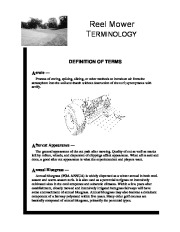 Toro Reel Mower TERMINOLOGY DEFINITION TERMS Aerate Process Coring Spiking Slicing Other Methods - 1 of 23
Toro Reel Mower TERMINOLOGY DEFINITION TERMS Aerate Process Coring Spiking Slicing Other Methods - 1 of 23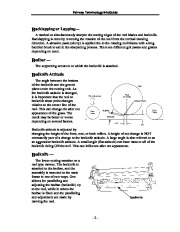 Toro Reel Mower TERMINOLOGY DEFINITION TERMS Aerate Process Coring Spiking Slicing Other Methods - 2 of 23
Toro Reel Mower TERMINOLOGY DEFINITION TERMS Aerate Process Coring Spiking Slicing Other Methods - 2 of 23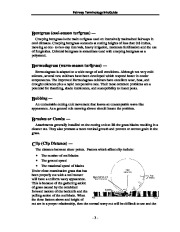 Toro Reel Mower TERMINOLOGY DEFINITION TERMS Aerate Process Coring Spiking Slicing Other Methods - 3 of 23
Toro Reel Mower TERMINOLOGY DEFINITION TERMS Aerate Process Coring Spiking Slicing Other Methods - 3 of 23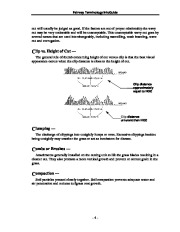 Toro Reel Mower TERMINOLOGY DEFINITION TERMS Aerate Process Coring Spiking Slicing Other Methods - 4 of 23
Toro Reel Mower TERMINOLOGY DEFINITION TERMS Aerate Process Coring Spiking Slicing Other Methods - 4 of 23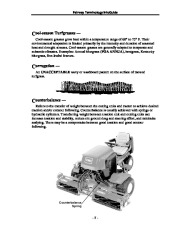 Toro Reel Mower TERMINOLOGY DEFINITION TERMS Aerate Process Coring Spiking Slicing Other Methods - 5 of 23
Toro Reel Mower TERMINOLOGY DEFINITION TERMS Aerate Process Coring Spiking Slicing Other Methods - 5 of 23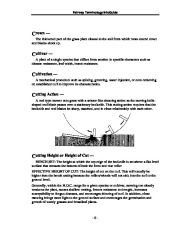 Toro Reel Mower TERMINOLOGY DEFINITION TERMS Aerate Process Coring Spiking Slicing Other Methods - 6 of 23
Toro Reel Mower TERMINOLOGY DEFINITION TERMS Aerate Process Coring Spiking Slicing Other Methods - 6 of 23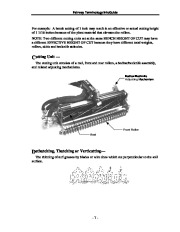 Toro Reel Mower TERMINOLOGY DEFINITION TERMS Aerate Process Coring Spiking Slicing Other Methods - 7 of 23
Toro Reel Mower TERMINOLOGY DEFINITION TERMS Aerate Process Coring Spiking Slicing Other Methods - 7 of 23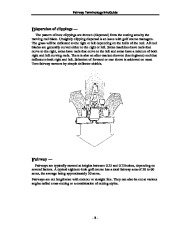 Toro Reel Mower TERMINOLOGY DEFINITION TERMS Aerate Process Coring Spiking Slicing Other Methods - 8 of 23
Toro Reel Mower TERMINOLOGY DEFINITION TERMS Aerate Process Coring Spiking Slicing Other Methods - 8 of 23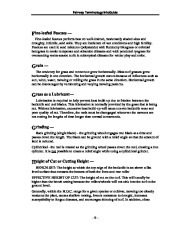 Toro Reel Mower TERMINOLOGY DEFINITION TERMS Aerate Process Coring Spiking Slicing Other Methods - 9 of 23
Toro Reel Mower TERMINOLOGY DEFINITION TERMS Aerate Process Coring Spiking Slicing Other Methods - 9 of 23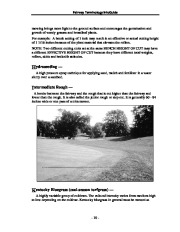 Toro Reel Mower TERMINOLOGY DEFINITION TERMS Aerate Process Coring Spiking Slicing Other Methods - 10 of 23
Toro Reel Mower TERMINOLOGY DEFINITION TERMS Aerate Process Coring Spiking Slicing Other Methods - 10 of 23